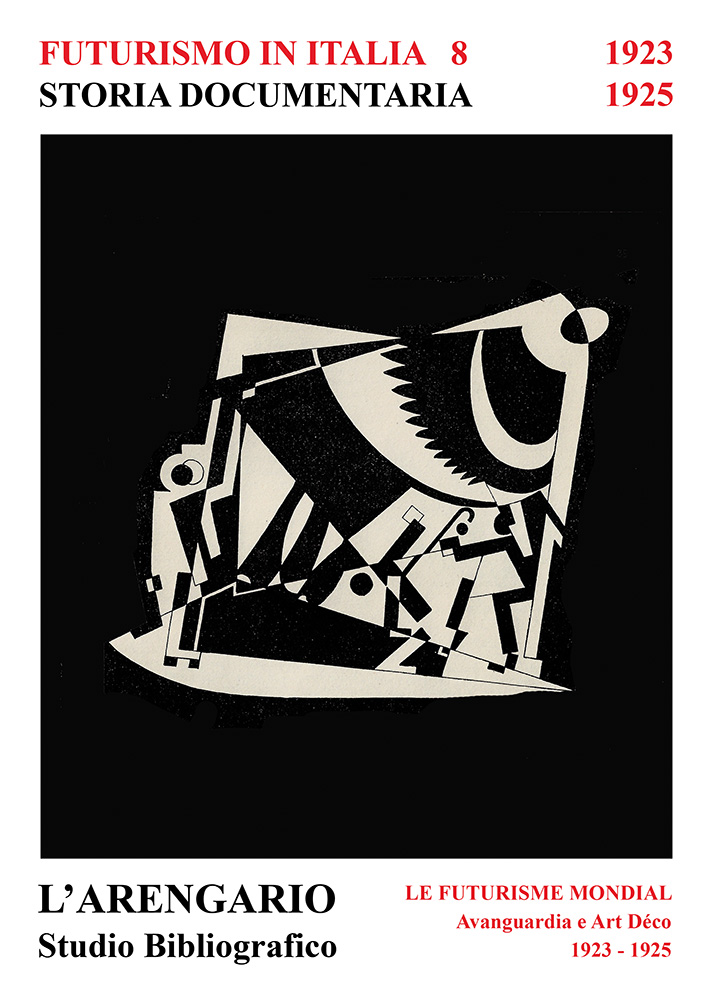L'ARENGARIO STUDIO BIBLIOGRAFICO - Dott. Paolo Tonini
Futurismo in Italia - 8. Le Futurisme mondial. Avanguardia e Art Déco (1923 - 1925)
Luogo: Cellatica
Editore: L'Arengario Studio Bibliografico, "Storia Documentaria del Futurismo in Italia - 8"
Stampatore: prodotto in proprio
Anno: 2023 (27 dicembre)
Legatura: brossura
Dimensioni: 29,7x21 cm.
Pagine: pp. VII (1) - 118 (4) compresa la copertina
Descrizione: copertina illustrata con la riproduzione di un disegno di Enrico Prampolini («Le famose serate futuriste»). Catalogo interamente illustrato a colori, 118 schede ragionate, a cura e con testo introduttivo di Paolo Tonini («Internazionalismo futurista / «Futurist internationalism»). Edizione digitale.
Bibliografia: N. D.
Prezzo: N. D.ORDINA / ORDER
"Beata gioventù. Pensavano davvero che l’arte avrebbe cambiato la politica. F.T. Marinetti pubblicava l’11 marzo 1923 il manifesto «I diritti artistici propugnati dai futuristi italiani». Fra le numerose proposte, la principale è la creazione di un istituto bancario partecipato dallo Stato che acquisendo le opere permetta agli artisti creatori di lavorare. Marinetti tiene anche a precisare che sono stati gli artisti a ideare quella “rivoluzione” che il fascismo vorrebbe intraprendere. Nell’aprile 1923 Enrico Prampolini avvia la seconda serie della rivista NOI, strumento di diffusione delle idee d’avanguardia di respiro internazionale. [...] A ribadire l’importanza dell’orientamento internazionale è ancora F.T. Marinetti che l’11 gennaio 1924 pubblicava il manifesto «Le futurisme mondial», rivendicando l’influenza decisiva del futurismo italiano su tutte le avanguardie. [...] E a sancire uno stretto rapporto a livello internazionale fra arte e industria è infine la «Exposition Internationale des Arts Décoratifs et Industriels Modernes» di Parigi, inaugurata il 28 aprile 1925: il fascino conturbante dell’Art Déco sintetizzava spregiudicatezza e stili delle avanguardie dal Futurismo al Bauhaus..." (dal testo introduttivo).
"Blessed youth. They really thought that art would change politics. On 11 March 1923, F.T. Marinetti published the manifesto about «The artistic rights advocated by the Italian futurists». Among the numerous proposals, the main one is the creation of a state-owned banking institution which, by acquiring the works, allows the creative artists to work. Marinetti is also keen to point out that the artists devised the “revolution” that fascism would like to undertake. In April 1923 Enrico Prampolini launched the second series of the magazine NOI, a tool for disseminating the international avant-garde ideas. [...] And again F.T. Marinetti, reiterating the importance of international orientation, on 11 January 1924 published the manifesto about «Le futurisme mondial», claiming the decisive influence of Italian futurism on all avant-gardes. [...] And finally, the «Exposition Internationale des Arts Décoratifs et Industriels Modernes» in Paris, inaugurated on 28 April 1925, established definitively a close relationship between art and industry at an international level: the disturbing charm of Art Déco synthesized the unscrupulousness and styles of the avant-gardes from Futurism to the Bauhaus...".
DOWNLOAD PDF FILE
"Blessed youth. They really thought that art would change politics. On 11 March 1923, F.T. Marinetti published the manifesto about «The artistic rights advocated by the Italian futurists». Among the numerous proposals, the main one is the creation of a state-owned banking institution which, by acquiring the works, allows the creative artists to work. Marinetti is also keen to point out that the artists devised the “revolution” that fascism would like to undertake. In April 1923 Enrico Prampolini launched the second series of the magazine NOI, a tool for disseminating the international avant-garde ideas. [...] And again F.T. Marinetti, reiterating the importance of international orientation, on 11 January 1924 published the manifesto about «Le futurisme mondial», claiming the decisive influence of Italian futurism on all avant-gardes. [...] And finally, the «Exposition Internationale des Arts Décoratifs et Industriels Modernes» in Paris, inaugurated on 28 April 1925, established definitively a close relationship between art and industry at an international level: the disturbing charm of Art Déco synthesized the unscrupulousness and styles of the avant-gardes from Futurism to the Bauhaus...".
DOWNLOAD PDF FILE

